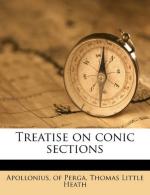|
This section contains 537 words (approx. 2 pages at 300 words per page) |

|
Imagine there are two cone-shaped paper drinking cups, each fastened to the other at its point, or vertex. The figure that would result is described mathematically as a right circular cone (sometimes called a double cone), which is formed by a straight line that moves around the circumference of a circle while passing through a fixed point (the vertex) that is not in the plane of the circle.
If a right circular cone is cut, or intersected, by a plane at different locations, the intersections form a family of plane curves called conic sections (see the figure). If the intersecting plane is parallel to the base of the cone, the intersection is a circle—which shrinks to a point when the plane has moved toward the cone's tip and finally passes through the vertex. If the intersecting plane is not parallel to the base, passes through...
|
This section contains 537 words (approx. 2 pages at 300 words per page) |

|


